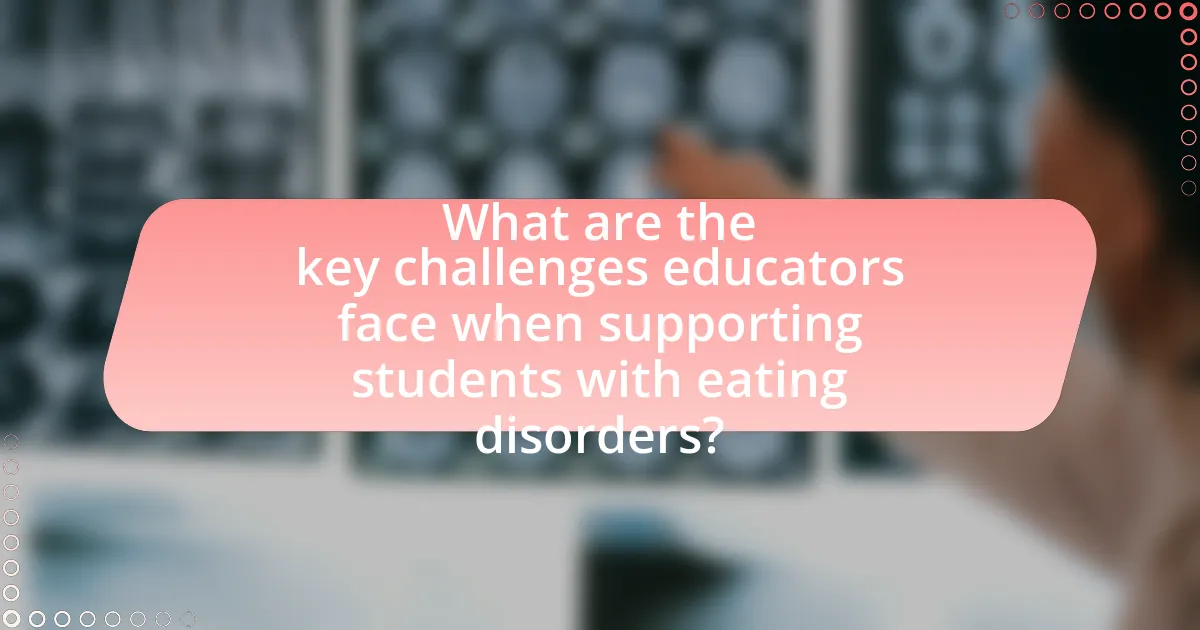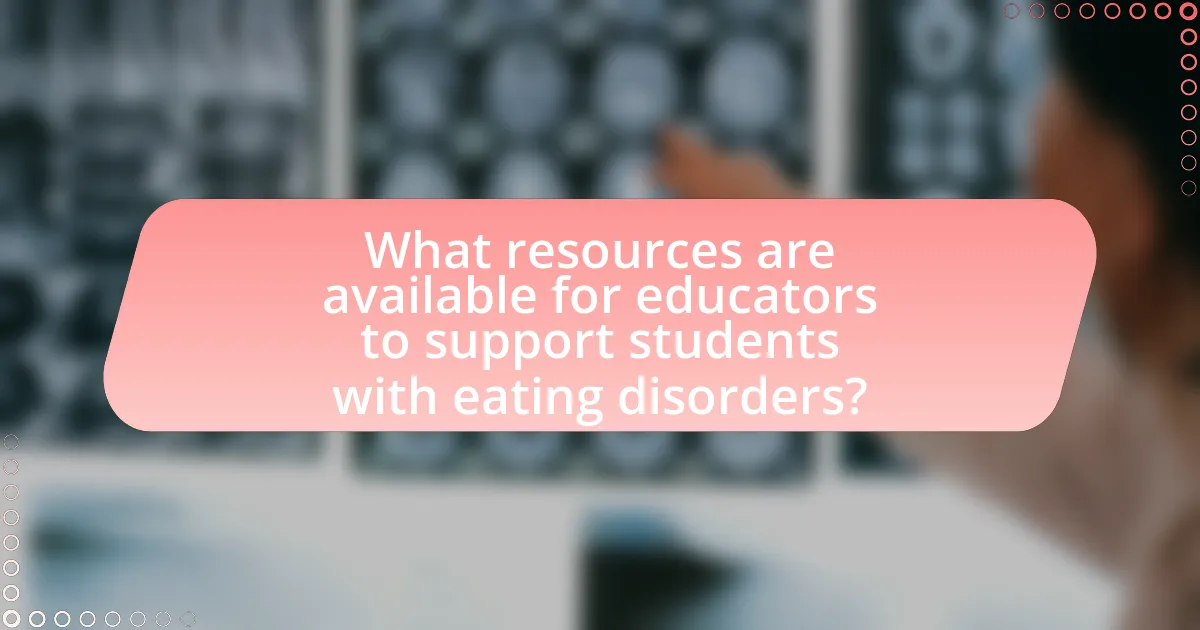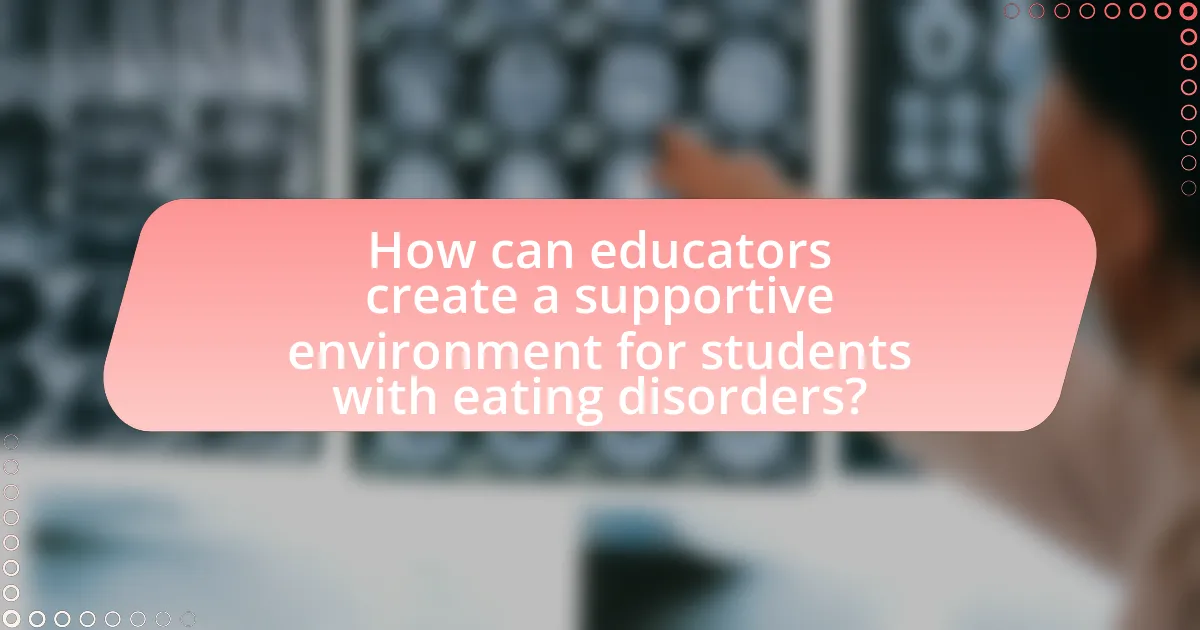The article focuses on the essential resources and strategies educators need to support students with eating disorders in schools. It outlines the key challenges educators face, such as lack of training, stigma, and communication barriers, which hinder effective intervention. The article emphasizes the importance of recognizing behavioral and physical signs of eating disorders, understanding their impact on academic performance, and fostering supportive relationships between students and teachers. Additionally, it discusses available training programs, the role of school counselors, and practical tips for creating an inclusive environment that promotes open communication and collaboration with parents.

What are the key challenges educators face when supporting students with eating disorders?
Educators face several key challenges when supporting students with eating disorders, including lack of training, stigma, and communication barriers. Many educators are not adequately trained to recognize the signs of eating disorders or to provide appropriate support, which can hinder early intervention. Stigma surrounding mental health issues often prevents open discussions, making it difficult for students to seek help or for educators to address the issue effectively. Additionally, communication barriers between educators, parents, and healthcare providers can complicate the support process, leading to fragmented care and insufficient resources for students. These challenges highlight the need for comprehensive training and resources to better equip educators in supporting affected students.
How can educators identify signs of eating disorders in students?
Educators can identify signs of eating disorders in students by observing changes in behavior, physical appearance, and emotional well-being. Specific indicators include significant weight loss or gain, preoccupation with food, dieting, or body image, and withdrawal from social activities. Research indicates that approximately 30% of adolescents with eating disorders exhibit noticeable behavioral changes, such as increased irritability or mood swings, which can signal underlying issues. Additionally, physical signs like dental erosion, fatigue, or gastrointestinal problems may further suggest an eating disorder. Recognizing these signs early can facilitate timely intervention and support for affected students.
What behavioral changes should educators look for?
Educators should look for significant changes in students’ eating habits, social interactions, and academic performance as indicators of potential eating disorders. For instance, a noticeable decline in meal participation or drastic weight fluctuations can signal unhealthy eating behaviors. Additionally, withdrawal from social activities or friends may indicate emotional distress related to body image issues. Academic performance may also decline due to preoccupation with food or body image, which can affect concentration and motivation. Recognizing these behavioral changes is crucial for early intervention and support.
How can physical symptoms indicate an eating disorder?
Physical symptoms can indicate an eating disorder through observable changes in body weight, nutritional deficiencies, and alterations in physical health. For instance, significant weight loss or gain, extreme fluctuations in weight, or a body mass index (BMI) outside the normal range can signal disorders such as anorexia nervosa or bulimia nervosa. Additionally, symptoms like fatigue, dizziness, hair loss, and gastrointestinal issues often arise from malnutrition or unhealthy eating patterns, which are common in individuals with eating disorders. Research shows that approximately 30% of individuals with eating disorders experience physical complications that can be life-threatening, underscoring the importance of recognizing these symptoms for early intervention and support.
Why is it important for educators to understand eating disorders?
It is important for educators to understand eating disorders because they play a crucial role in identifying and supporting affected students. Educators are often the first to notice changes in a student’s behavior or physical appearance that may indicate an eating disorder, which affects approximately 9% of the population, according to the National Eating Disorders Association. By recognizing the signs early, educators can facilitate timely intervention, promote a supportive environment, and connect students with appropriate mental health resources, ultimately improving the students’ academic performance and overall well-being.
What impact do eating disorders have on academic performance?
Eating disorders significantly impair academic performance by affecting cognitive function, concentration, and attendance. Students with eating disorders often experience fatigue, anxiety, and depression, which can lead to decreased motivation and engagement in school activities. Research indicates that these disorders can result in lower grades and higher dropout rates; for instance, a study published in the Journal of Adolescent Health found that adolescents with eating disorders had a 30% higher likelihood of failing classes compared to their peers. Additionally, the National Eating Disorders Association reports that students with these conditions frequently miss school due to health complications, further hindering their academic success.
How can understanding eating disorders improve student-teacher relationships?
Understanding eating disorders can significantly improve student-teacher relationships by fostering empathy and effective communication. When teachers are knowledgeable about the complexities of eating disorders, they can better recognize the signs and symptoms in students, leading to timely interventions. Research indicates that supportive teacher-student relationships enhance students’ emotional well-being and academic performance, particularly for those struggling with mental health issues. For instance, a study published in the Journal of School Psychology found that students who felt understood by their teachers were more likely to engage positively in the classroom and seek help when needed. This understanding creates a safe environment where students feel valued and supported, ultimately strengthening the bond between students and teachers.

What resources are available for educators to support students with eating disorders?
Educators can access various resources to support students with eating disorders, including training programs, counseling services, and educational materials. Organizations such as the National Eating Disorders Association (NEDA) provide comprehensive resources, including toolkits for educators, which outline how to recognize signs of eating disorders and strategies for intervention. Additionally, the Academy for Eating Disorders offers professional development opportunities focused on understanding and addressing eating disorders in school settings. Research indicates that early intervention and support can significantly improve outcomes for students, highlighting the importance of these resources in educational environments.
What types of training programs exist for educators?
Various training programs exist for educators, specifically designed to enhance their skills in supporting students with eating disorders. These programs include workshops focused on recognizing signs of eating disorders, strategies for intervention, and creating supportive classroom environments. Additionally, online courses provide flexible learning options on topics such as mental health awareness and inclusive teaching practices. Research indicates that training in these areas significantly improves educators’ confidence and effectiveness in addressing the needs of affected students, thereby fostering a more supportive educational atmosphere.
How can professional development enhance educator awareness?
Professional development enhances educator awareness by providing targeted training and resources that equip educators with knowledge about specific issues, such as eating disorders. This training often includes evidence-based practices, current research findings, and strategies for identifying and supporting students facing these challenges. For instance, a study published in the Journal of School Health found that educators who participated in professional development focused on mental health were significantly more likely to recognize signs of eating disorders and intervene appropriately. This increased awareness ultimately leads to better support for students, fostering a more inclusive and responsive educational environment.
What specific skills can educators gain from training programs?
Educators can gain skills in identifying and addressing eating disorders, implementing supportive interventions, and fostering a positive school environment through training programs. These programs often provide knowledge on the psychological and physical aspects of eating disorders, enabling educators to recognize warning signs and understand the complexities of these conditions. Additionally, training equips educators with strategies for effective communication with students and families, as well as collaboration techniques with mental health professionals. Research indicates that educators who participate in specialized training are better prepared to support students, leading to improved student outcomes and a more inclusive school culture.
What role do school counselors play in supporting students with eating disorders?
School counselors play a crucial role in supporting students with eating disorders by providing emotional support, facilitating access to resources, and promoting awareness within the school community. They assess students’ needs, offer counseling sessions, and collaborate with parents and teachers to create a supportive environment. Research indicates that early intervention by school counselors can significantly improve outcomes for students struggling with eating disorders, as they can help identify warning signs and connect students with appropriate mental health services. Additionally, counselors can implement educational programs to raise awareness about eating disorders, fostering a culture of understanding and support among peers.
How can counselors collaborate with educators to create a supportive environment?
Counselors can collaborate with educators to create a supportive environment by developing integrated support plans that address the specific needs of students with eating disorders. This collaboration involves regular communication between counselors and educators to share insights about students’ emotional and academic challenges, ensuring that educators are equipped to recognize signs of distress and provide appropriate accommodations. Research indicates that schools with strong counselor-educator partnerships report improved student outcomes, as these collaborations foster a holistic approach to student well-being, enhancing both academic performance and mental health support.
What resources can counselors provide to educators and students?
Counselors can provide a variety of resources to educators and students, including educational materials on eating disorders, referral services for mental health professionals, and support groups for students. These resources help educators understand the complexities of eating disorders and equip them to support affected students effectively. For instance, counselors can offer workshops that educate staff on recognizing signs of eating disorders and implementing appropriate interventions. Additionally, counselors can facilitate access to local mental health services, ensuring that students receive the necessary professional support. Research indicates that schools with comprehensive counseling programs see improved student outcomes, highlighting the importance of these resources in fostering a supportive educational environment.

How can educators create a supportive environment for students with eating disorders?
Educators can create a supportive environment for students with eating disorders by fostering open communication, promoting body positivity, and implementing individualized support plans. Open communication allows students to feel safe discussing their struggles, which is essential for their emotional well-being. Promoting body positivity helps to counteract negative societal messages about body image, creating a more inclusive atmosphere. Individualized support plans, tailored to each student’s needs, ensure that educators can address specific challenges and provide appropriate resources. Research indicates that supportive school environments significantly improve the mental health outcomes for students with eating disorders, highlighting the importance of these strategies.
What strategies can educators implement in the classroom?
Educators can implement strategies such as creating a supportive classroom environment, promoting open communication, and integrating social-emotional learning to support students with eating disorders. A supportive environment fosters trust and safety, which is crucial for students struggling with these issues. Open communication allows students to express their feelings and concerns, facilitating better understanding and support from educators. Additionally, integrating social-emotional learning helps students develop coping skills and resilience, which are essential for managing their challenges. Research indicates that these strategies can significantly improve the well-being and academic performance of students facing mental health issues, including eating disorders.
How can classroom policies promote inclusivity and understanding?
Classroom policies can promote inclusivity and understanding by establishing clear guidelines that foster a supportive environment for all students, particularly those with eating disorders. These policies can include training for educators on recognizing and addressing the needs of students with diverse backgrounds and challenges, ensuring that all students feel valued and understood. Research indicates that inclusive classroom environments lead to improved academic performance and emotional well-being, as seen in studies like “The Impact of Inclusive Education on Student Outcomes” published in the Journal of Educational Psychology, which found that inclusive practices significantly enhance student engagement and reduce stigma. By implementing such policies, schools can create a culture of empathy and respect, ultimately benefiting the entire student body.
What role does communication play in supporting affected students?
Communication plays a crucial role in supporting affected students by facilitating understanding, fostering trust, and enabling effective intervention strategies. Clear and open communication allows educators to identify the specific needs of students with eating disorders, ensuring that appropriate support mechanisms are in place. Research indicates that when educators engage in regular dialogue with students, it enhances the students’ sense of safety and belonging, which is essential for their emotional well-being. Furthermore, effective communication among educators, parents, and mental health professionals ensures a coordinated approach to care, which is vital for the recovery process of students facing these challenges.
What best practices should educators follow when addressing eating disorders?
Educators should prioritize creating a supportive and non-judgmental environment when addressing eating disorders. This involves fostering open communication, where students feel safe discussing their concerns without fear of stigma. Research indicates that early intervention is crucial; therefore, educators should be trained to recognize the signs of eating disorders, such as drastic weight changes or behavioral shifts related to food. Additionally, collaborating with mental health professionals can provide students with the necessary resources and support. According to the National Eating Disorders Association, schools that implement comprehensive programs that include education on body image and nutrition significantly reduce the prevalence of eating disorders among students.
How can educators approach sensitive conversations with students?
Educators can approach sensitive conversations with students by creating a safe and supportive environment that encourages open dialogue. Establishing trust is crucial; educators should actively listen, validate students’ feelings, and use empathetic language to foster a sense of security. Research indicates that a supportive atmosphere can significantly improve student engagement and willingness to discuss personal issues, including eating disorders. For instance, a study published in the Journal of School Health highlights that when educators demonstrate understanding and compassion, students are more likely to share their struggles, leading to timely interventions and support.
What are effective ways to involve parents in the support process?
Effective ways to involve parents in the support process include regular communication, educational workshops, and collaborative goal-setting. Regular communication ensures that parents are informed about their child’s progress and challenges, fostering a supportive environment. Educational workshops provide parents with knowledge about eating disorders, enabling them to understand their child’s experiences and needs better. Collaborative goal-setting encourages parents to participate actively in creating achievable objectives for their child, enhancing their commitment to the support process. Research indicates that parental involvement significantly improves treatment outcomes for students with eating disorders, highlighting the importance of these strategies.
What practical tips can educators use to support students with eating disorders?
Educators can support students with eating disorders by fostering a safe and understanding environment. This includes being aware of the signs of eating disorders, such as drastic weight changes or social withdrawal, and approaching students with empathy and without judgment. Educators should also collaborate with mental health professionals to create individualized support plans that address the specific needs of each student. Additionally, promoting a healthy body image and providing education on nutrition can help reduce stigma and encourage positive behaviors. Research indicates that supportive school environments can significantly improve the well-being of students with eating disorders, highlighting the importance of proactive measures in educational settings.


